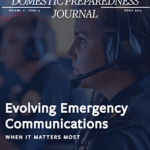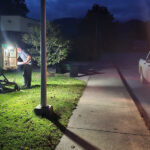- Agriculture & Food Defense, Articles, CBRNE, Communication & Interoperability, Critical Infrastructure, Emergency Management, Emergency Medical Services, Fire, Law Enforcement, Public Health, Transportation
- Judy Kruger and Scott Harris
March 11, 2011, is known for the Great East Japan Earthquake (or 3.11 in Japan). The day started as a rainy and cold day when a 9.1 earthquake caused numerous aftershocks that led to power outages, created cracks in roads and buildings, triggered a massive tsunami along the east coast of Japan, and damaged the Fukushima nuclear power plant. Despite widespread damage that led to the deaths of nearly 16,000 people, Tokyo Disney Resort (TDR) withstood the impact due to engineering controls and numerous drills and exercises conducted at the resort in collaboration with the government (Central and Chiba government and local government) and private organizations (Oriental Land Company, OLC; Walt Disney Attraction Japan, WDAJ). Private-public partnerships (PPP) can help build a resilient infrastructure for communities and businesses and facilitate cross-sectoral coordination to deal with cascading events during a major catastrophe.
Only recently has the Emergency Support Function (ESF) #14 been established to represent emergency management’s business and infrastructure capability. This function supports efforts to coordinate cross-sector operations, including stabilizing key supply chains among infrastructure owners and operators, businesses, and government partners. Companies like TDR have the primary responsibility of managing their systems in emergencies. Risk reduction is a multidisciplinary collaboration between the private and public sector organizations and is often initiated before an event. Partnership arrangements often require multiple in-kind resources and contracts from various organizations. In this case, TDR had planned for rescue supply storage, first aid supply storage, and food supply storage with the Ministry of Internal Affairs and Communications and the Fire and Disaster Management Agency.
Legacy Agreements Help Inform That Process
Tokyo Disneyland first opened to guests in 1982. Early on, the Oriental Land Company (licensed owner and operator of TDR) collaborated with local and national government agencies to ensure that they had systems in place to be able to care for park guests and cast members for up to 48 hours following a significant incident. Japan has well-defined regulations that apply to the public and private sectors and include preparation before and recovery following an incident.

The TDR Crisis Management Team shared operational guidelines with strategic partners to address operating guidance gaps and increase Japan’s preparedness. Resilience-building efforts and operational integration before, during, and after the trifecta were the foundation that led to success. Leading up to 3.11, TDR worked with the Crisis Management Team and Operations Training Team to test various communication tools and identify infrastructure failures. Together, they developed additional processes in agreement with OLC to better manage future events and better plan for fire, seismic activity, tsunami, and terror-related threats.
Well-established relationships before disaster strikes are key to success. Private-public partnerships can serve as a force multiplier to reduce future losses.
Communication Networks
After the trifecta event (i.e., seismic activity, tsunami, radiation link), local phone lines and the internet did not work. Cellphone lines were down temporarily until they were switched over to the emergency services to support communications. Emergency operations centers (EOC) at the park and city center of Urayasu opened to monitor events. The TDR EOC was open around the clock for almost 48 hours. Guidance from the Japanese Ministry of Transport informed TDR that the rail lines were closed and bus systems were not operable as the bridges closed in the Tokyo area. Messages were relayed via the public address system on a loudspeaker to communicate with guests and cast members. The EOC helped coordinate information, connect field operations, and bring in OLC engineers to inspect buildings to identify secure places to get out of the cold and rain. Cast members provided comfort to guests (handed out blankets, food, and water) based on their training. Satellite phones were available onsite at TDR in Japan to provide immediate access within the first 24 hours with domestic Japanese partners and U.S. Disney leadership.
After all the buildings were inspected, guests were relocated to safety and were provided food and accommodations. At the guidance of OLC, TDR housed and sheltered in place nearly 30,000 guests and cast members for almost 24 hours after the seismic event. Following the 3.11 event, crisis management teams from TDR and operators in the U.S. (i.e., Disney Crisis Management team in Burbank, CA, Disney Human Resources, and Global Security) met daily for one month to share updates regarding safety plans, lessons learned, and recovery efforts.
TDR is driven by addressing the needs of its guests, cast members, services, and facilities managers. Through PPP, the company created unique opportunities with the public sector to proactively collaborate with the government (local police, fire department, local emergency management offices, and community partners) to support coordinated response efforts and facilitate communication and information sharing. Relationship building takes time and effort but is critical to successful operations.
Since TDR was able to remain nimble in a rapidly changing environment and facilitate cross-sector information sharing, they could leverage their resources successfully. In addition, because OLC had a great reputation with the local government and Japanese citizens trusted the local authorities, guests flocked back immediately when the OLC’s chief executive officer said it was safe to reopen TDR after five weeks of being closed.
Regular Drill and Exercises
Preparation and planning for major earthquake (intensity of ~6-7) exercises – facilitated by OLC in partnership with WDAJ and the Disney Global Crisis Management team from Burbank, California – include up to 350 cast members and 1,900 guests. They also engage in ongoing awareness programs (e.g., newsletters, videos, table pop-up cards, and other collateral information on initiation responses to fires, earthquakes, etc.) for cast members and guests.
Because it is common in Japan to experience earthquakes and tsunamis, part of the TDR operational plan was to conduct frequent small drills (~180 annually with restaurants, merchandise stores, attractions, etc. until 2020 when the park closed due to COVID; in 2022, 100+ drills are scheduled with more expected in 2023) and two annual table-top exercises in collaboration with all levels of government, park teams, and partners (vendors, police, emergency services, etc.). To this day, drills are conducted early in the morning before the park opens or after closing in the winter months to test smaller local situations around one of the attractions or sections of the park and include TDR cast members as victim actors.
Conclusion
Tokyo Disney Resort is one of the most integrated themed resorts in the world because the Japanese government has been so involved in disaster planning and preparedness to build resilience through PPPs. The introduction of cross-sector business and infrastructure coordination across operations to stabilize and increase communication led to all OLC parks and resorts worldwide and major business hubs having a primary EOC and a backup location.
Case studies are now being developed based on the benchmark that TDR had limited disruption in services following the trifecta disaster and reopened in a relatively short time. This benchmark emphasizes the need for preparation through regular drills, exercises, and training of cast members and guests to increase reaction time in crisis management.

Judy Kruger
Judy Kruger, Ph.D., is an associate professor at Emory University in the Gangarosa Department of Environmental Health, Rollins School of Public Health. She is a certified business continuity professional (CBCP) and a certified emergency manager with Georgia Emergency Management and Homeland Security (GA CEM). She has responded to several national disasters and is a crisis coach, preparing business and industry leaders for business continuity and disaster response and recovery. She can be reached at jkruger@emory.edu
- Judy Krugerhttps://domesticpreparedness.com/author/judy-kruger
- Judy Krugerhttps://domesticpreparedness.com/author/judy-kruger
- Judy Krugerhttps://domesticpreparedness.com/author/judy-kruger
- Judy Krugerhttps://domesticpreparedness.com/author/judy-kruger

Scott Harris
Scott Harris is the Director of Security Strategy & Integration and Sensitive Information Protection for the Walt Disney Company. He started his career at the Disneyland Resort in 1985. In addition to his domestic experience, he has participated in four international assignments for the Grand Opening efforts for Disneyland Paris, Tokyo DisneySea, Hong Kong Disneyland, and Shanghai Disney Resort. He is an alum of the Executive Leaders Program at the Naval Postgraduate School, Center for Homeland Defense and Security. He can be reached at scott.t.harris@disney.com
- Scott Harrishttps://domesticpreparedness.com/author/scott-harris






